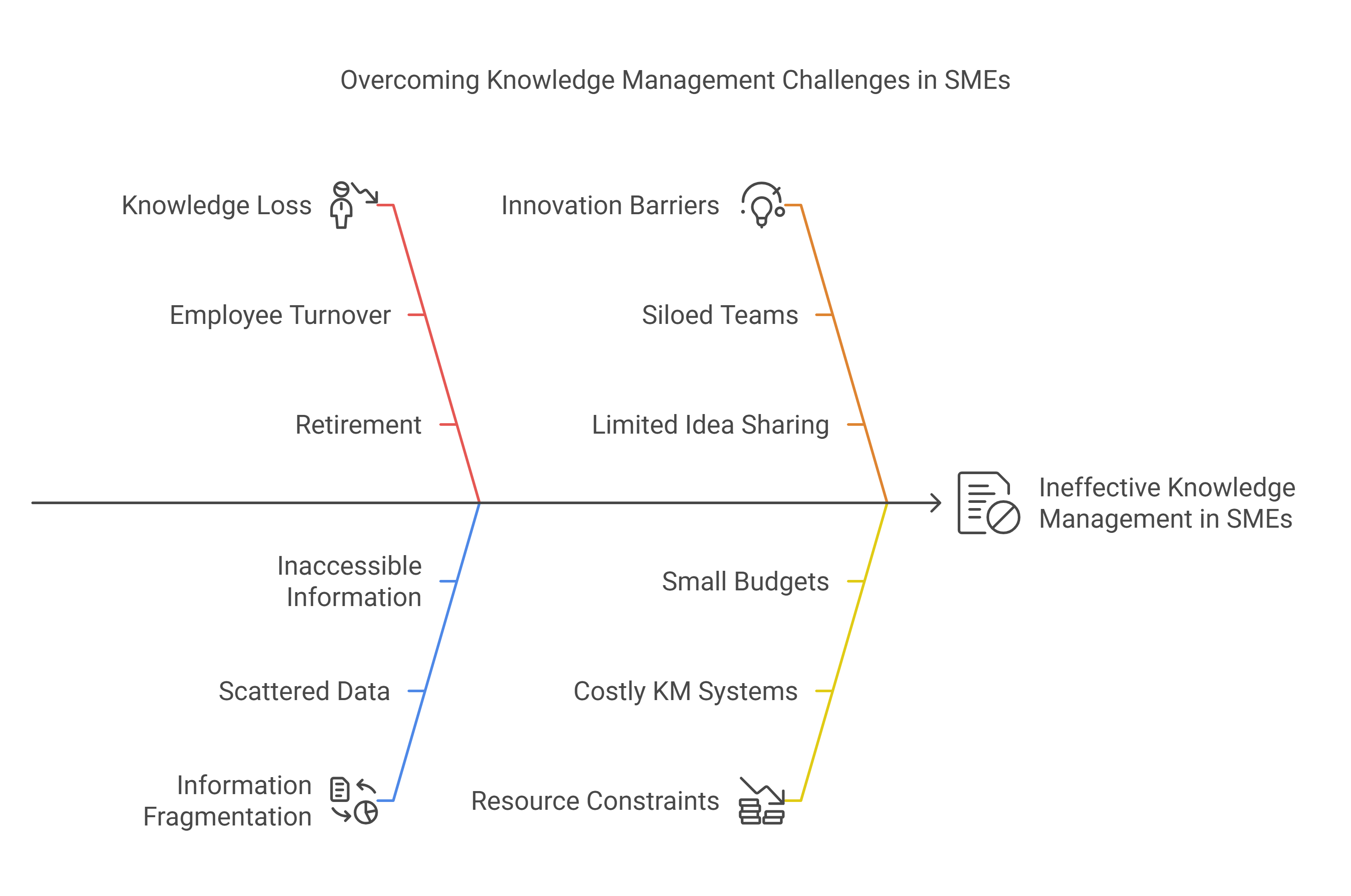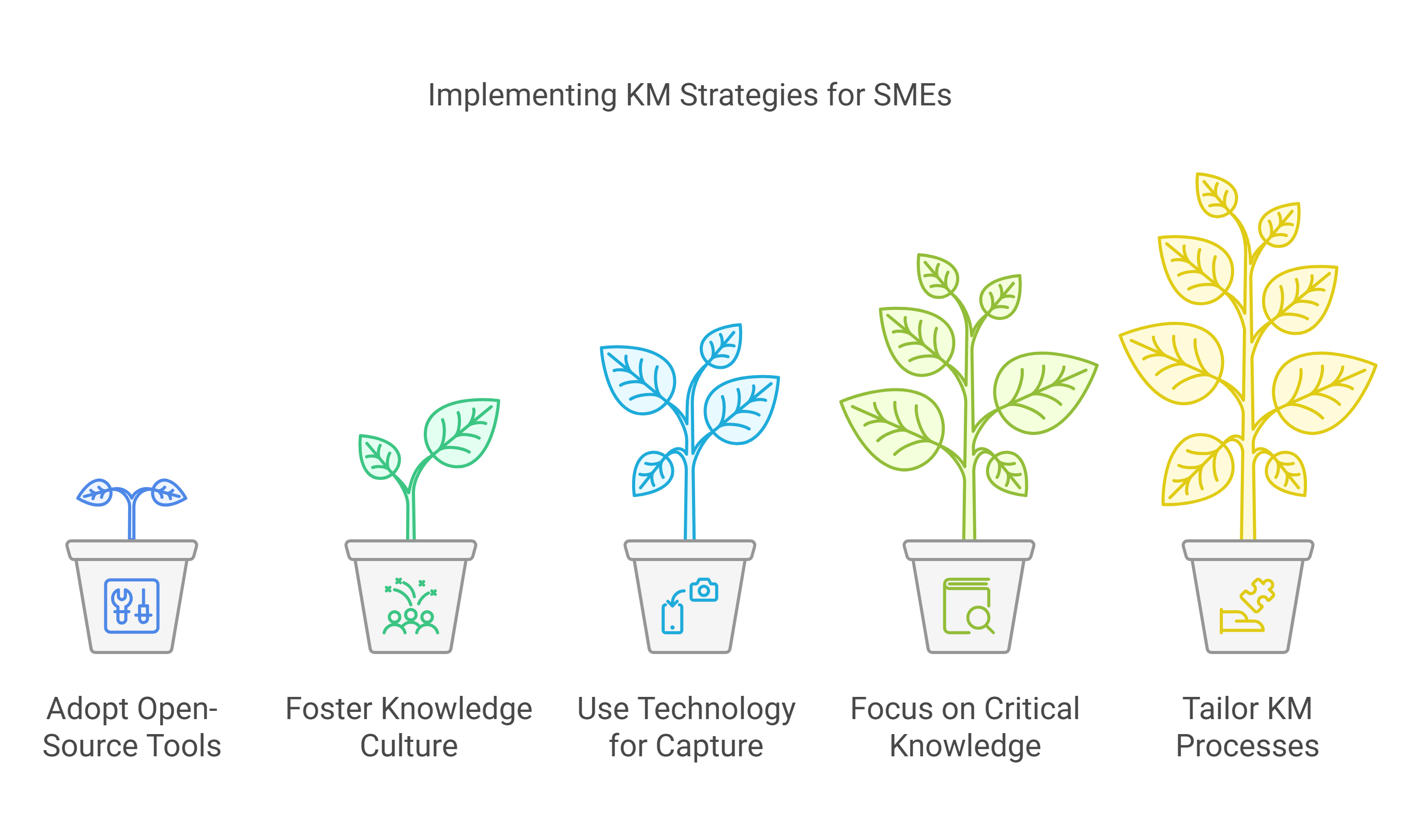1. Why Knowledge Management Matters for SMEs
Small and medium-sized enterprises (SMEs) operate in fast-changing markets. They juggle tight budgets, shifting customer demands, and limited staff. Knowledge management (KM) can be a powerful tool to address these challenges. Effective KM prevents knowledge loss, supports innovation, and boosts efficiency. It also helps SMEs remain competitive—even if a key employee leaves with years of know-how.
Imagine your head of engineering resigns. She carries a wealth of insight about suppliers, designs, and production shortcuts. Without a system that captures her knowledge, you scramble to fill the gap. Production stalls. Morale suffers. Customer orders get delayed. This scenario underscores the stakes. By treating knowledge as a strategic asset, SMEs can stay agile, creative, and resilient, even when staff transitions occur.
This article explores KM’s role in helping SMEs adapt and compete. We’ll examine why many small firms struggle with knowledge sharing, the benefits of a well-structured KM program, and practical ways to embed KM in daily routines. We’ll also touch on future trends—like AI—that promise to reshape how SMEs manage ideas and expertise. In doing so, we’ll show how knowledge management can become a vital edge for growth and stability.
2. The Knowledge Management Challenge for SMEs
2.1 Knowledge Loss from Turnover or Retirement
People move on. They retire, switch companies, or pursue new ventures. A small firm may lack the resources to do a formal “knowledge handover.” Vital tips or processes vanish once an expert is gone. This risk escalates in technical roles, where employees store detailed know-how in their heads.
2.2 Fragmented or Inaccessible Information
SMEs often run on lean structures. They rely on everyday tools like shared folders, email threads, or random sticky notes. Over time, data piles up, scattered across different drives or personal laptops. Staff waste time hunting for files or rewriting existing templates. Productivity suffers.
2.3 Innovation Barriers from Limited Sharing
When teams work in silos, they miss cross-pollination of ideas. Without a culture of open knowledge exchange, brainstorming stays local. Innovation stalls. Competitors that share lessons and best practices progress faster, outpacing more secretive firms.
2.4 Resource Constraints Hindering Formal KM
Many SMEs assume advanced KM systems are too costly or complex. They have fewer employees and smaller budgets. So they skip formal KM, hoping informal chats can suffice. Yet as the business grows, these informal practices collapse under heavier demands. Missed opportunities pile up.

3. Strategic Benefits of Knowledge Management for SMEs
3.1 Enhanced Competitiveness
Research shows that knowledge sharing can be a sustainable competitive advantage. When you store and refine your best ideas, you stand out from rivals who rely on ad hoc measures. Clients sense that you’re more organized, consistent, and reliable.
3.2 Improved Innovation Performance
In a knowledge-driven world, fresh ideas fuel progress. Documented best practices spark new thinking. Cross-departmental collaboration triggers new products or improved processes. By capturing staff suggestions in a central system, you create a cycle of idea generation and problem-solving.
3.3 Operational Efficiency
Busy SMEs need to eliminate duplication or guesswork. If staff can’t locate a crucial file, they might rebuild it from scratch. That leads to wasted effort. A strong KM system, especially if open-source (like Nextcloud or DokuWiki), centralizes data. People quickly find what they need, reducing delays and mistakes. (Connection to Article V7 on efficiency gains.)
3.4 Business Continuity
When an employee leaves, you don’t want chaos. KM helps preserve routines and know-how. Each process has a written guide or reference. Newcomers learn fast by reading the docs or checking the wiki. Knowledge continuity lowers the chance of crisis if a key staffer disappears. (Connection to Article V6 on knowledge transfer.)
3.5 Agility and Resilience
Markets shift fast, especially for SMEs. They must pivot, add new offerings, or adapt to fresh regulations. KM speeds this response. Teams share updates swiftly. They leverage existing knowledge to handle the new scenario. Firms that embrace KM bounce back from disruptions more smoothly.
4. Practical KM Implementation Strategies for SMEs
4.1 Adopt Cost-Effective, Open-Source Tools
SMEs often fear high software fees. However, open-source platforms like DokuWiki (for documentation) or Nextcloud (for file sharing) can be budget-friendly. These tools also integrate well with collaboration apps like Mattermost or Slack.
- DokuWiki: Good for text-based process notes, meeting summaries, or staff guides.
- Nextcloud: Handles larger files (like PDFs, images, or spreadsheets) with access controls.
- Mattermost: Allows real-time chat, notifications, and knowledge Q&A sessions.
4.2 Foster a Knowledge-Sharing Culture
Leaders must set the example. They show that knowledge isn’t proprietary but a shared asset. They invite staff to post solutions or lessons learned. Incentives—like awarding “Contributor of the Month”—spur engagement. A supportive culture helps employees feel safe asking or sharing info.
4.3 Use Technology for Knowledge Capture and Dissemination
Besides wikis, SMEs can embed short videos, audio notes, or diagrams. This variety accommodates different learning styles. They can also rely on integrated search, so staff can type a keyword and find relevant docs or policy pages instantly.
4.4 Focus on Critical Knowledge First
Not all topics demand detailed documentation. Identify your SME’s key processes—like sales, product design, or supply chain steps. Document these crucial areas thoroughly, ensuring staff rely on them daily. Over time, you expand coverage to secondary processes.
4.5 Tailor KM Processes to SME Needs
You don’t need a massive, corporate-style KM department. Begin small—maybe a monthly knowledge-sharing session or a single wiki page per process. Keep each doc brief. Staff can add detail over time. This nimble approach suits SMEs better than rigid, complex frameworks.

5. Overcoming KM Implementation Challenges
5.1 Resource Constraints
Issue: SMEs worry about the cost of staff hours or new systems.
Solution: Start with minimal, cost-free tools (open-source). Roll out one pilot project. Show clear ROI—like reduced onboarding time or fewer mistakes. Management may then back a broader KM rollout.
5.2 Cultural Barriers
Issue: Some employees hoard knowledge, fearing job insecurity. Others see doc creation as busywork.
Solution: Emphasize mutual benefits. Show how knowledge sharing simplifies everyone’s tasks. Recognize staff who help others. Build trust by showing that documented roles aren’t threatened—they’re just more consistent.
5.3 Balancing Formal and Informal Approaches
Issue: Too much formal structure can choke creativity. Too little leads to chaos.
Solution: Combine quick Slack or Mattermost chats with structured wiki pages. Capture key insights from casual discussions in a short doc. A middle path keeps knowledge flexible yet reliable.
5.4 Enhancing Absorptive Capacity
Issue: Some SMEs gather lots of external data but fail to use it effectively.
Solution: Train staff on how to read market reports or competitor analyses. Summarize those insights in bullet points. Host short sessions to discuss how new info applies to daily operations. Encourage staff to adapt external ideas in creative ways.
6. Future Trends in KM for SMEs
6.1 AI and Machine Learning
Tools that auto-tag documents or suggest relevant articles can save time. AI chatbots may answer routine queries, freeing staff for deeper tasks. SMEs could tap open-source AI frameworks, customizing them for domain-specific knowledge. Over time, these systems might predict knowledge gaps and prompt staff to fill them.
6.2 External Knowledge Sources and Open Innovation
Collaboration no longer stops at company walls. SMEs might partner with universities, clients, or even competitors to co-develop solutions. That demands a robust KM system to track external inputs, shared patents, or co-created designs. The future sees more synergy beyond your building.
6.3 KM in Sustainability and ESG Initiatives
Growing pressure for ethical and eco-friendly actions pushes SMEs to track their resource usage or supply chain steps. KM helps store and verify these data points. It also helps staff share best practices for greener operations. Over time, this fosters a culture that merges knowledge with social responsibility.
7. Conclusion: Knowledge as a Strategic Asset for SME Growth
Knowledge management isn’t just a side project. It’s a pillar of strategic planning that defends against employee turnover, fosters creativity, and keeps operations lean. In SMEs, every staffer counts. A single lost procedure can derail a project. By organizing knowledge effectively, small firms can act bigger, adapt faster, and punch above their weight.
We’ve seen how KM can secure continuity, spur innovation, and unify teams around shared docs. By adopting open-source tools, encouraging a collaborative culture, and focusing on critical processes first, SMEs can build a solid knowledge base. Overcoming hurdles like cost or cultural reluctance paves the way for sustained success.
How do you tackle knowledge management in your SME? Have you tried open-source solutions, or do you rely on ad-hoc practices? Share your stories and challenges. Let’s spark a conversation on how best to preserve and grow the vital expertise that drives your business forward.
#KnowledgeManagement
#SMELeadership
#Innovation
#CompetitiveAdvantage
#OpenSourceTools
